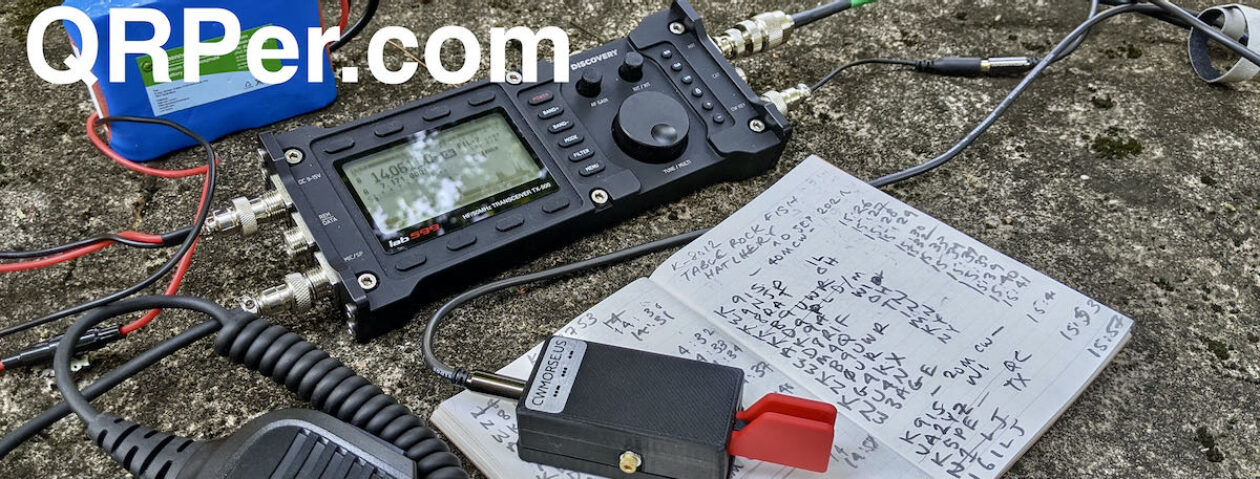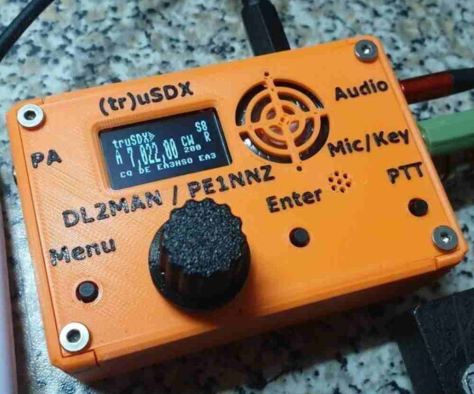
I mentioned in a previous post that I placed an order for a (tr)uSDX kit with roWaves in February. My order was placed for a third production run kit and I assumed I would receive it sometime in March 2022.
Later that month, I discovered that DL2MAN announced AliExpress would sell both kits and fully-assembled versions of the (tr)uSDX. I used the link from DL2MAN’s website and ordered a fully-assembled unit.
My thinking was that I would receive the kit first, build it, then test the performance by comparing it with the factory-assembled unit. These units are so dang affordable I felt like I could splurge for both.
roWaves order on hold
I recently discovered that my (tr)uSDX kit had been placed on hold due to issues that popped up in the first and second kit group buys via roWaves.
Evidently–and someone can correct me if I’m wrong here–the first and second production runs kits had a component issue that equated to lower output power. In addition, Josh (KI6NAZ), reports that the early group orders had no boot loaded and the MCU was DOA.
I’ll patiently wait for roWaves to sort this out. I’m not in a huge hurry at this point because, frankly, my available time to build a kit has come and gone. The next few months, I’ve a lot of plans, travels, and projects to work through.
Fully-assembled (tr)uSDX
 Much to my surprise, the assembled (tr)uSDX arrived Monday and I picked it up when I was at home on Tuesday of this week.
Much to my surprise, the assembled (tr)uSDX arrived Monday and I picked it up when I was at home on Tuesday of this week.
I was only home one night, but managed to do some quick testing.
I soldered Anderson Powerpole connectors on the supplied power cable pigtails. Next, I hooked the (tr)uSDX up to my variable power supply and a dummy load.
A quick test showed that I was getting about 3 watts of output power with about 13-13.2 volts, 3.25 watts at 13.8 volts, and 2 watts of power with 9-10 volts. This is lower than the expected 5 watts of output power @ 13.8 volts. The current consumption in receive however was about 60 mA even at 9 volts. That’s slightly below the published specs.
I honestly had no time that evening to play radio, but I took a moment to hook up the (tr)uSDX to my skyloop antenna just to check the audio quality in SSB.
As luck would have it, the first station I heard on 40 meters was a POTA activator in Ohio. He was calling CQ, so I couldn’t help but reply. I pressed the PTT button on the (tr)uSDX, spoke into the internal mic, and he came back immediately with a 5×8 report. My meter was showing a max of 2 watts output power–the heavy lifting, of course, was done by the antenna.
This gave me a very good initial impression!
(tr)uSDX POTA Activation

The following morning, after running a few errands and carting my kids to some appointments, I left the QTH for a couple nights of travel.
I just couldn’t help but pack the (tr)uSDX and attempt a park activation en route. My goal was to see if it had enough positive receiver characteristics to be a proper POTA/SOTA portable rig–the feature set is comprehensive for a $135 radio.

I stopped by South Mountains State Park and paired the (tr)uSDX to an EFHW my buddy Steve (MW0SAW) kindly built and sent me. [Steve–I’m loving this antenna! Thanks again, OM!]
I made a video of the entire activation and will soon post the field report. I’ll push this video to the front of the line, but with my internet bandwidth, it might still be a few days before I can post it. Because of this, I thought I’d go ahead and share some of my experience with the (tr)uSDX in case you’ve been thinking of purchasing one.
(tr)uSDX pros
 This little radio design has a lot going for it.
This little radio design has a lot going for it.
The chassis is very compact–perhaps the size of two Altoids tins stacked on top of each other. The encoder does protrude–in fact, it’s nearly as deep as the radio chassis. It’s not that the encoder is particularly tall, it’s just that the (tr)uSDX is so wee.
The radio has all of the CW adjustments you’d typically find in a compact field transceiver and even sports QSK (there’s also a semi QSK setting) with no relay noise. I assume it uses PIN diode switching.
(tr)uSDX Cons

Unfortunately, I did find a few negatives. The reviewer in me automatically gives the (tr)uSDX wide berth and a lot of forgiveness: we’re talking about a $135 transceiver here. I don’t think anyone is under the impression this would be a stellar performer.
In my opinion, the biggest negative is the (tr)uSDX audio. This little rig has a very high noise floor–perhaps S5 or S6.
The internal speaker is very modest and mine is incapable of producing audio at a level that is workable in the field where there are ambient noises like wind, water, conversations, birds, etc. The audio sounds decent when working a strong station, but weak stations are extremely hard to hear. If you turn up the volume on my unit beyond level 14, the audio simply squeals. I need to tinker with the volume control more.
Since the audio was so weak, I hooked up my Sony digital audio recorder to the (tr)uSDX headphone jack and made a separate audio recording for the upcoming activation video.
The headphone audio is louder, but there’s also a lot of noise in the audio amplification chain–again placing the (tr)uSDX noise floor around S5 or S6.
I was fully expecting the (tr)uSDX receiver to overload and it does. The variable filter helps and narrowing it makes the audio sound more pleasant in CW, but it doesn’t stop adjacent signals from bleeding through. Honestly, though? I could live with this and just use the filter between my ears if the audio was simply cleaner.
I also discovered that my unit needs alignment: the frequency display is off by 1.6 kHz in CW mode on 40 meters. I’ve put this on my to-do list–after all, this is a project radio meant for hands-on tweaking. I’m good with that.
One final point and minor quibble: the OLED display is very difficult to read outdoors. It’s superb indoors, but outside any sunlight or reflection simply wipes it out. To read the display I had to cover it with my hand.
The activation was a success: I worked 11 stations in 20 minutes or less, but I’m sure there were weaker signals out there I missed because they were simply buried in the (tr)uSDX’s noise floor.
I liked the (tr)uSDX keying, and I love the form factor, but I’m not sure I’ll ever use this radio again–configured as it is now–during an activation. For casual contacts, it could still be fun.
A little (tr)uSDX grace
 I mean…$135 right?!?
I mean…$135 right?!?
The (tr)uSDX is an open source project and truly pushes the boundaries of what one can achieve for $135–again, even much less for the kit version. Frankly, I’m in absolute awe that any transceiver can be made below the $150 price point; especially a multiband, multimode transceiver.
The (tr)uSDX is an experimenter’s radio and I plan to dig into this little unit and see if there’s anything I can do to lower that noise floor. My hope is that the CPU or display may simply need better grounding or isolation. My time is limited at the moment, but I will open into this radio in the next few weeks.
In fact, eventually completing the kit build will give me an opportunity to explore the components and connections in much better detail.
I do know that my unit also seems to have the power output issue that some of the roWaves kits have. I can’t achieve anything better than 3.25 or 3.5 watts output at 13.8 volts. It should be about 5 watts at 13.8 V.
I would welcome your suggestions especially if you’ve built the (tr)uSDX kit or if you’ve put your assembled (tr)uSDX on the air and found that it had much better audio characteristics.
 As I mentioned in a post published three days ago, I’m now the proud owner of a (tr)uSDX QRP transceiver.
As I mentioned in a post published three days ago, I’m now the proud owner of a (tr)uSDX QRP transceiver. On Wednesday, March 30, 2022, I took the (tr)uSDX to the field to attempt a Parks On The Air (POTA) activation. I had only taken delivery of the (tr)uSDX about 15 hours beforehand and had only had it powered up for a total of 30 minutes the previous day. Most of that time, in fact, was checking the power output at various voltage settings into a dummy load. I did make one totally random SSB POTA contact shortly after hooking the radio up to my QTH antenna.
On Wednesday, March 30, 2022, I took the (tr)uSDX to the field to attempt a Parks On The Air (POTA) activation. I had only taken delivery of the (tr)uSDX about 15 hours beforehand and had only had it powered up for a total of 30 minutes the previous day. Most of that time, in fact, was checking the power output at various voltage settings into a dummy load. I did make one totally random SSB POTA contact shortly after hooking the radio up to my QTH antenna.



















